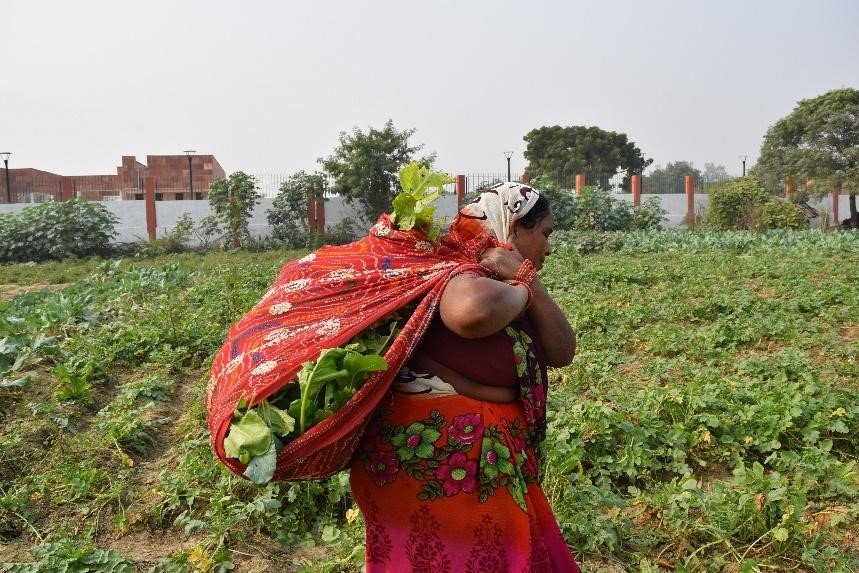The Feminisation of Climate Change Economics

Rising Temperatures and Falling Economy
India was ranked amongst the top 10 countries most affected by the adverse effects of climate change, by the Global Climate Risk Index, 2021. While colder countries like Norway are gaining economic benefits with advancing warmer climates, higher temperatures in India are causing large scale cumulative losses. A parabolic relationship between temperature and economic growth reveals that there is greater than 90 per cent likelihood for India’s per capita GDP to be much lower now than if global warming were not a factor (Diffenbaugh and Burkefound, 2019) and a recent Stanford study concurred that the economy is 31 per cent smaller than it could be otherwise.
India is now experiencing the consequences of 1°C rise in global warming. Extreme heatwaves, heavy rainfall, severe flooding, destructive storms and rising sea levels are damaging lives, livelihoods and assets. A recent report by the ODI, based on projections of temperature and precipitation changes affecting labour productivity in various sectors, points out that climate related risks in the country will increase inequality and poverty. India might lose 3-10 per cent of its GDP with poverty rising by 3.5 per cent now and losses going up to 2.6 and 13.4 per cent, if global temperature rises by 2°C and 3°C respectively.
Bearing the Brunt: Sectors and Communities
The ODI report shows that districts in India with rapid temperature rises have had 56 per cent lower growth in GDP than those that warmed the slowest. Insidious effects of climate change leading to higher temperatures and sustained heat waves are hampering outdoor labour work, with an estimated 10 working hours lost, severely affecting economic growth. Also, about 90 per cent of the excess heat, naturally stored in the oceans, has led to reduced fish populations affecting around 650 to 800 million people in the fisheries industry
An analysis of the Ganges-Brahmaputra-Meghna and Mahanadi deltas, a major cropland area and one of India’s biggest export sources, shows that climate change induced effects on agriculture has led to economic losses amounting from 18-32 per cent of GDP. Food production, due to changes in farming practices with climate change, is under high risk and with it, India’s food security. The farm sector output, accounting for 16 per cent of India’s GDP has been falling due to unseasonable rains and frequent droughts resulting in, for example, the lowest sugar output in 3 years in Maharashtra. If this continues, supplementary import costs will weigh greater on the already struggling trade economy.
Any possible combination of rising cereal prices, declining wages in the agricultural sector and the slower rate of economic growth attributable to climate change will increase India’s population of poor by 50 million within 2040, rural populations predictably bearing the brunt. Rising seas and stronger storms are driving crop-killing seawater further inland and farmers out. The need for better income has been driving India’s rural residents from villages to cities, climate-induced uncertainty in agriculture aggravating the process. The Economic Survey of India 2017 estimated inter-state migration at 9 million annually between 2011 and 2016 with majorly male agricultural labourers moving to cities in search of jobs. Women on the other hand are left behind to continue farm work, leaving them vulnerable to agrarian crises.
Putting on the Gender Lens: Women in the Weeds
In the last decade, research on climate change effects has widely scripted that related phenomena does not impact men and women equally. According to United Nations reports, women, comprising majority of the world’s poor and more dependent for their livelihood on natural resources that are threatened by climate change, are much more vulnerable to the effects of climate change than men. Negative effects of climate change on populace most dependent on natural resources and changing ecosystems has resulted in more men leaving home to find income elsewhere, putting additional burden on the women left back home to both earn and manage households. 80 per cent of farmers are now women, says the UN Women office (India), but women in India, subject to discriminatory societal norms are not given landownership nor do they have knowledge of or access to farming technologies. Additionally, with the government not formally identifying women as farmers; state and the central government benefits to agricultural landowners and farmers do not trickle down to these women.
Ironically, women are worse hit both during agricultural crises and natural disasters with catastrophic floods and cyclones leaving women and children doubly vulnerable owing to mobility constraints within communities. They face greater negative physical and psychological health issues due to climate change and pollution. Even poorly employed women lose their jobs in the aftermath of such disasters, leaving them without income or resources and more susceptible to sexual violence and abuse, resulting in psychological trauma incapacitating them for education or employment. An estimated 84 per cent (ILO 2021) of such women with ‘vulnerable employment’ are amongst those worst affected.
Climate Migrants: Women on the Move
Extreme weather conditions leading to loss of livelihood, climate induced hardships and the whirlpool of instability, poverty and desperation, has forced growing number of people, being referred to as ‘climate migrants’, to leave home in search of decent income. Severe flooding and incessant rains in the state of Uttarakhand, brought about mass migration of hard-hit rural communities. In the aftermath of the 2013 cyclone Phailin in Orissa, the state witnessed an unprecedented migration of fishing communities based there for decades before. Between 2008 and 2016, close to 1.5 million people were classified as internally displaced as a result of natural disasters in India, annually.
Mumbai’s migrant population comprises of many moving due to land degradation in the south and desertification and drought in the north. Women constitute an overwhelming majority of such migrants. Demand for labour remains gendered with female migrants less represented in regular jobs and more likely to be self-employed or stuck in low-skilled niche jobs like domestic work and child care in city households. CARE International points out that climate change exacerbates existing gender inequalities, with women displaced on the frontlines of its impacts bearing the heaviest consequences with hard labour and no decent jobs or income because of their limited educational and economic standing.
In the Beed district of Maharashtra, several women migrate every year from the drought-prone Marathwada region to the sugarcane farms of western Maharashtra to work as cane cutters and undergo voluntary hysterectomies for fear that they will not be hired if they demand off days during their menstrual cycles or pregnancies. In the Sundarbans, regularly battling cyclonic floods and a hostile ecosystem, women migrate during the rice-growing season every year to Odisha only to engage in back breaking labour, planting rice and working at a shrimp farms, from dawn to early evening.
These migrants form a class of invisible workers, working in poor conditions in brick kilns or agriculture, with no access to government services or labour schemes and often pushed into deep debts and even bondage.
Climate Resilience: Women on the Frontlines
A gendered perspective on migration is imperative since women have significantly different migration motivations, patterns, options and obstacles than men. NGOs like Swayam Shikshan Prayog (SSP) has been training female farmers and helping them access pure water and proper sanitation in addition to advocating for their landowner status. Bringing women into the renewable energy sector growing in India is another imminent step toward their collective development and fight against climate change. In Chennai, Gujrat and UP women are being taught to manufacture, use and maintain solar lights by networks like SSP and Solar Sahelis. Engaging women in climate change mitigation is also important, with their fundamental knowledge of the ecosystem, to bring about novel solutions at the grass root level, create employment and better income. However the government sector needs to pitch in at a much larger sale to create and support such initiatives and bring forward female-focused policies by educating and giving them a seat at the table in local and national policy-making. Only when female stakeholders, learning to adapt to the myriad effects of climate change on their primary livelihoods and day-to-day life, become decision makers in principle sectors will they be better equipped to fight climate change and realise the empowerment we strive for every day.
Rhitabrita Mukherjee is a Senior Research Associate at IWWAGE, and has worked extensively in the areas of social infrastructure, gendered economics, food security and ecological economics.
- Posted In:
- Latest Blogs






















































Leave a Reply